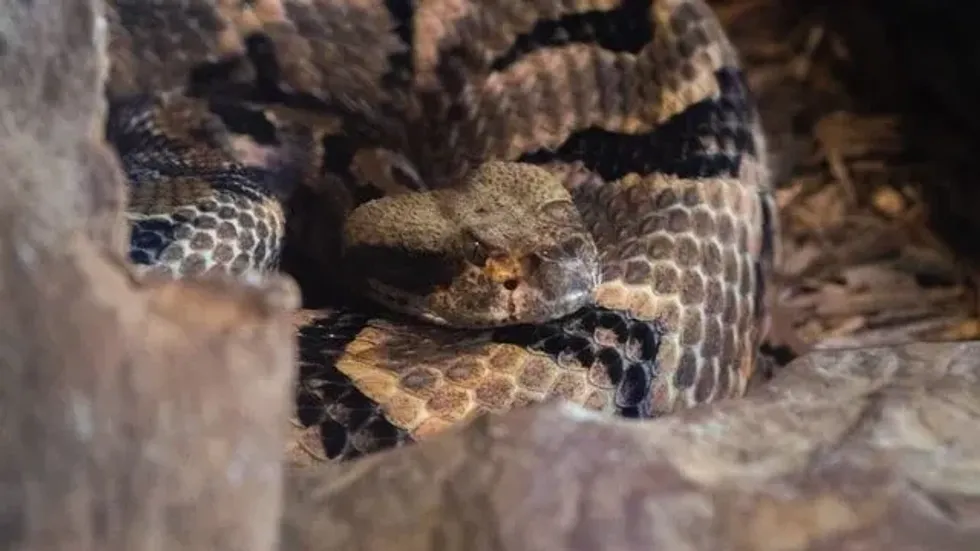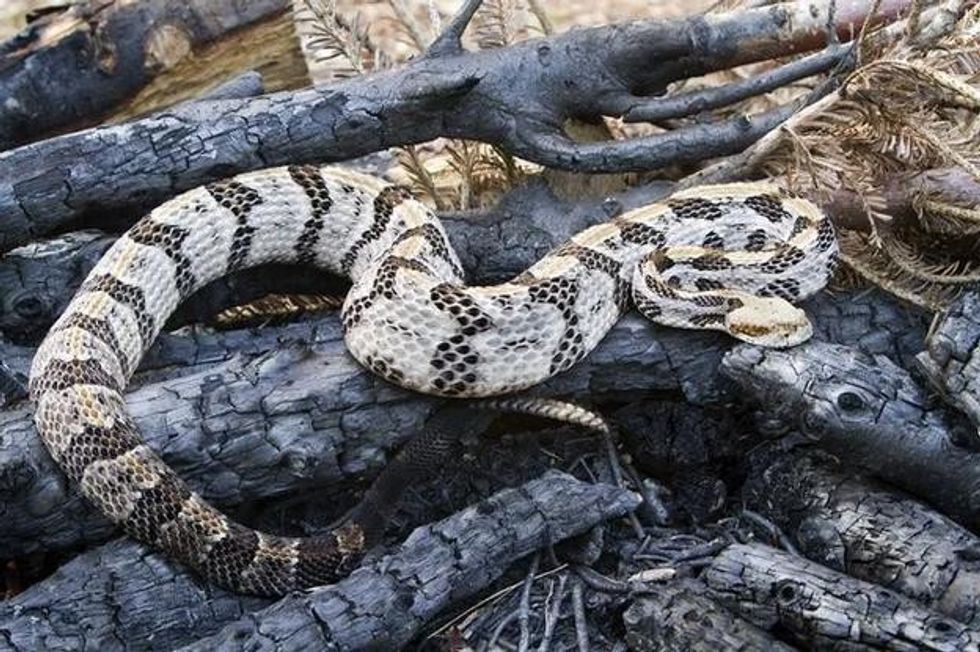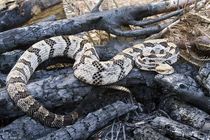Fun Timber Rattlesnake Facts For Kids

The timber rattlesnake is a pit viper that is found in the Eastern United States. In northern America, they are the most distributed snakes.
In all of the USA, they are second in number only to their cousin the prairie rattlesnake that which is found in the western parts of the country. The adult timber rattlesnake is about 36-60 in (91- 150 cm) long and weighs about 1-3 lb (0.4-1.3 kg). In this species, the males are usually larger than the females.
The timber rattlesnake can be identified by the V-shaped brown or black marks down its gray or yellow body. They also have a distinguished rattler at the end of their tail. This rattler puts them in the rattlesnake category.
When they feel agitated or threatened, timber rattlesnakes shake this rattler to warn their enemies. The rattler makes a buzzing sound to alert the enemies.
The timber rattlesnake is a very venomous snake. Though they rarely bite humans, their bites can be deadly if not treated immediately. The timber rattlesnake's venom has been known to kill a person within 6-48 hours of the biting.
These snakes are found in North America and most of Eastern America. They also hibernate during the winter months. If you want to know more interesting Eastern timber rattlesnake facts, keep reading this article.
If you want to learn more amazing facts about animals, then check out green anaconda and corn snake.
Timber Rattlesnake Interesting Facts
What type of animal is a timber rattlesnake?
The timber rattlesnake (Crotalus horridus) is a species of venomous pit viper snake that is found in Eastern North America.
What class of animal does a timber rattlesnake belong to?
The timber rattlesnake (Crotalus horridus) belongs to the Reptilia class of the Animalia kingdom.
How many Timber Rattlesnakes are there in the world?
The exact number of Timber Rattlesnakes is unknown. However, we know that they are classified as Least Concern in the IUCN Red List.
This means, that despite having a declining population, there are enough of them alive that they are not a more threatened species. But individual states of the USA are taking necessary measures to protect this species and has classified their status as threatened and endangered in certain states.
Where does a timber rattlesnake?
The timber rattlesnake can be found in the Eastern United States. Historically they were found in the United States and Canada. But they are not found in Canada any more. In the United States, Minnesota, Kansas, Iowa, Texas, Florida, New Hampshire, and Indiana are a few places where these snakes can be found.
What is a timber rattlesnake's habitat?
The timber rattlesnake is mostly found in hilly, deciduous forests and floodplains. The snakes found in the western, elevated parts are called the Timber Rattler, and the ones found in the lower elevation areas such as the Atlantic coastal plain are called the Canebrake Rattlesnake.
While pregnant, female Timber Rattlesnakes are prone to go to hotter, open spaces while the males and non-pregnant females look for cooler, enclosed crevices and rocky ledges.
They also cannot stand the cold and tend to hibernate during the winter. They hibernate in their dens for almost five to six months every winter.
Who do Timber Rattlesnakes live with?
Like other rattlesnakes, Timber Rattlesnakes mostly live alone only coming together during mating season. During hibernation, they are seen to navigate to a place with a lot of other Timber Rattlesnakes and hibernate together. This gives them safety in numbers. It also makes scientists wonder that there might be a subtle but complex social structure present in these creatures.
How long does a Timber Rattlesnake live?
In the wild, Timber Rattlesnakes live for about 10-20 years. They might even live longer than that. In captivity, however, their lifespan increases to almost 30 years. The oldest Timber Rattlesnake lived in captivity for almost 36.5 years.
How do they reproduce?
The reproduction process of the Timber Rattlesnake is very interesting. The males follow the scent of the pheromones of the receptive females and try to mate with them. Sometimes the males fight among themselves for dominance.
After the mating, the females usually store the sperm in their bodies and go into hibernation. They only activate the sperm after they have come out of hibernation. Thus begins the fertilization process.
The Timber Rattlesnakes are ovoviviparous. This means they carry and hatch the eggs in their bodies but give birth to live young. The females give birth to live neonates in the autumn of the following year of their mating. They can give birth to 5-13 baby snakes on average.
Larger females can give birth to more neonates. The babies are about 7-14 in (20-35 cm) long. They are not born with their rattlers but they grow them later.
What is their conservation status?
In the IUCN Red List, the Timber Rattlesnake is listed as Least Concern. But the population of this snake is steadily decreasing. The main reason behind this is human activity. Habitat loss due to deforestation and other reasons are some of the main reasons for the decrease in their population. Poaching is also a reason behind their decreasing population.
Timber Rattlesnake Fun Facts
What do Timber Rattlesnakes look like?
The Timber Rattlesnakes are a species of pit vipers native to the United States. They are about 36-60 in (91-150 cm) long as adults and weigh around 1-3 lb (0.4-1.3 kg).
Though most adult snakes' weights are around the lower end of that scale. The females of this species weigh less than the males. Timber Rattlesnakes have very distinct patterns on their backs.
The background colors can be gray or tannish-yellow. while the patterns range from dark brown to velvety black.
On their backs, they have distinct V-shaped or M-shaped; brown or black patterns. Melanism is common in this species and some snakes can have very dark, almost black skin. They have stacked rattlers at the end of their tails that they shake to warn their enemies when threatened.
These rattlers make a buzzing noise that warns people of their location. They also have fangs that they use to deliver venom into the bodies of their prey or humans.
The neonates of this species are smaller in size. They are about 7-14 in (20-35 cm) long.
Even though they have some of the distinct pattern markings on their back when they are born, the babies are born with a grayish hue. They also have a button instead of their rattler. The rattler only starts to grow when they shed their skin for the first time.

How cute are they?
Even though cuteness is a matter of perception, generally Timber Rattlesnakes are not considered to be cute. They are shy snakes but they can be extremely dangerous. That combined with their fangs and deadly look, they cannot be called cute.
If you meet someone who loves these snakes, they will surely tell you how adorable they are, but please never approach the Timber Rattlesnake if you come across one. Instead, try to avoid it. Like all baby animals, baby Timber Rattlers can be cute.
How do they communicate?
The Timber Rattlesnakes are pit vipers, which means they have sensitive pit organs between their eyes and nostrils. They can feel slight changes in the weather and heat. They also rise vertically before attacking with their exposed fangs and that is their warning stance.
The males also fight among themselves before the mating season. The most common way for Timber Rattlesnakes to warn people is through their rattler. These make a buzzing noise that acts as their warning system.
This is a highly effective and evolved system against wild animals as well as humans. They also hiss as a sign of warning. Like other pit vipers, the Timber Rattlesnakes communicate with each other through pheromones.
How big is a Timber Rattlesnake?
The Timber Rattlesnakes can grow up to be about 36-60 in (91-150 cm) long. The longest recorded length of a Timber Rattlesnake was about 72 in (180 cm). They are large and heavy-bodied snakes.
How fast can a Timber Rattlesnake move?
Even though there is no conclusive data about the speed of Timber Rattlesnakes, they can move as fast as their other cousins. Especially while ambushing prey, the Timber Rattlesnake range can be about one to two-thirds of their body length.
And they can lunge forward this much in a second or two, giving their prey no way to escape out of their grasp.
How much does a Timber Rattlesnake weigh?
The Timber Rattlesnakes are one of the largest snake species in the United States. They are heavy-bodied and weigh around 1-3 lb (0.4-1.3 kg) on average. The male Timber Rattlesnakes are usually larger than the females of the species and weigh more.
What are their male and female names of the species?
There is no gender-specific name for the male and female Timber Rattlesnakes. The males are called male Timber Rattlesnakes and the females are called female Timber Rattlesnakes.
What would you call a baby Timber Rattlesnake?
Like every other snake species, the youngs of the Timber Rattlesnakes can be called a snakelet or neonate. Neonate is the more popular term to use for baby snakes.
What do they eat?
The Timber Rattlesnake's diet consists mostly of small mammals. They mostly prey on rodents like rats, squirrels, chipmunks, and shrews. They are also known to eat other reptiles and amphibians.
They also sometimes eat smaller snakes like the Garter snake. The Timber Rattlesnake neonates feed on small reptiles or mice because they are easier to swallow. They are deadly predators that ambush their prey by waiting in hiding for them.
It is easy because the bodies of the Timber Rattlesnakes can be easily camouflaged in the wild. When a prey nears them, the Timber Rattlesnakes strike and decapitate the prey with venom, and consume it. They only hunt and eat when they are hungry.
Are they poisonous?
Like other pit vipers, the Timber Rattlesnake is a venomous snake. Their venom is enough to kill a human if they are not treated immediately.
Among the United States' deadliest vipers, Timber Rattlesnakes have a high venom yield. But generally, they use their venom for hunting.
If they feel threatened by humans, they rattle their rattlers and feint before striking. Four venom patterns have been observed in this species of snakes. One is neurotoxic, one is hemorrhagic and proteolytic, the third is a mixture of these two patterns and the fourth is a weaker version of the Timber Rattlesnake venom.
The antivenom for this species is readily available, and there is a 99% chance of recovery if the bitten person is treated immediately. If not treated properly, the bitten person can die within 6-48 hours of the bite.
Would they make a good pet?
These snakes are not good pets. Firstly, the Timber Rattlesnake bite is deadly. With the amount of venom this species has, Timber Rattlesnakes are extremely dangerous to keep as pets.
Especially if you have children. There are zoos and animal sanctuaries that have Timber Rattlesnakes and they do relatively well in captivity. But it is extremely dangerous to keep them when if you are not an expert about how to handle venomous snakes like this.
Did you know...
Timber Rattlesnakes will travel about 1.6 mi (2.5 km) away from their dens.
The record length of the longest Timber Rattlesnake was 74.5 in (189 cm).
They are very camouflaged, which helps them in hunting for prey.
How to identify a Timber Rattlesnake
These snakes can be identified by the distinct V-shaped crossbar markings across their yellow and gray backs. They also have narrow necks and a wide head. But the most important identification method is the rattler at the end of its tail that they used to make a distinct buzzing sound when they are threatened.
Why are Timber Rattlesnakes endangered?
Timber Rattlesnakes are not an endangered species yet. They can be found over a vast range in the Eastern and northern United States.
Even though they are listed as Least Concern in the IUCN Red List, they are steadily decreasing in numbers due to reckless deforestation and habitat loss. Steps are being taken by individual states to save this animal from becoming endangered. These snakes are, however, considered endangered in certain US states and are a protected species.
Here at Kidadl, we have carefully created lots of interesting family-friendly animal facts for everyone to discover! Learn more about some other reptiles including sand lizard, or hognose snake.
You can even occupy yourself at home by drawing one on our Timber Rattlesnake coloring pages.
We Want Your Photos!
More for You
Sources
https://www.iucnredlist.org/species/64318/12765920
https://www.healthline.com/health/rattlesnake-bite#recovery-and-aftercare
https://www.fs.fed.us/database/feis/animals/reptile/crho/all.html#:~:text=Survival%20rates%20and%20mortality%3A%20Lifeits%20own%20prey%20%5B13%5D.
Bachelor of Arts specializing in Journalism and Mass Communication, Postgraduate Diploma in Sports Management

Moumita DuttaBachelor of Arts specializing in Journalism and Mass Communication, Postgraduate Diploma in Sports Management
A content writer and editor with a passion for sports, Moumita has honed her skills in producing compelling match reports and stories about sporting heroes. She holds a degree in Journalism and Mass Communication from the Indian Institute of Social Welfare and Business Management, Calcutta University, alongside a postgraduate diploma in Sports Management.
Bachelor of Technology specializing in Computer Science Engineering

Shray SharmaBachelor of Technology specializing in Computer Science Engineering
As an aspiring web and app developer, Shray has a passion for working with promising startups. He is currently pursuing a Bachelor's degree in Computer Science from Maharaja Surajmal Institute Of Technology while gaining experience in digital marketing. Shray has already earned a Google Analytics Certification and is well-equipped to handle analytics and data management tasks. He has also served as a marketing manager at Parallax Virtual Arts, where he oversaw the company's social media, content, and SEO strategies. Shray's goal is to create engaging content that resonates with audiences and offers valuable insights.
Disclaimer
1) Kidadl is independent and to make our service free to you the reader we are supported by advertising. We hope you love our recommendations for products and services! What we suggest is selected independently by the Kidadl team. If you purchase using the Buy Now button we may earn a small commission. This does not influence our choices. Prices are correct and items are available at the time the article was published but we cannot guarantee that on the time of reading. Please note that Kidadl is a participant in the Amazon Services LLC Associates Program, an affiliate advertising program designed to provide a means for sites to earn advertising fees by advertising and linking to Amazon. We also link to other websites, but are not responsible for their content.
2) At Kidadl, we strive to recommend the very best activities and events. We will always aim to give you accurate information at the date of publication - however, information does change, so it’s important you do your own research, double-check and make the decision that is right for your family. We recognise that not all activities and ideas are appropriate for all children and families or in all circumstances. Our recommended activities are based on age but these are a guide. We recommend that these ideas are used as inspiration, that ideas are undertaken with appropriate adult supervision, and that each adult uses their own discretion and knowledge of their children to consider the safety and suitability. Kidadl cannot accept liability for the execution of these ideas, and parental supervision is advised at all times, as safety is paramount. Anyone using the information provided by Kidadl does so at their own risk and we can not accept liability if things go wrong.
3) Because we are an educational resource, we have quotes and facts about a range of historical and modern figures. We do not endorse the actions of or rhetoric of all the people included in these collections, but we think they are important for growing minds to learn about under the guidance of parents or guardians.







